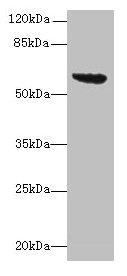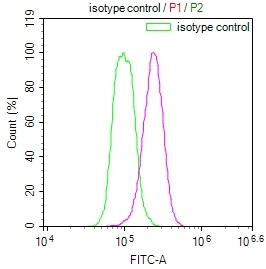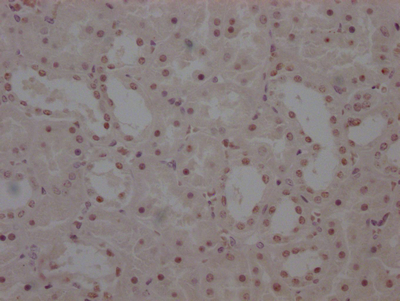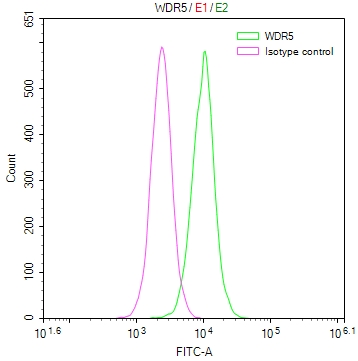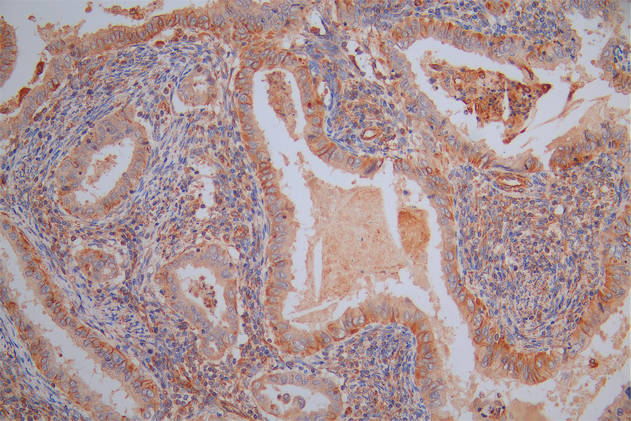-
中文名稱:tar兔多克隆抗體
-
貨號:CSB-PA356999HA01ENV
-
規格:¥440
-
圖片:
-
其他:
產品詳情
-
產品名稱:Rabbit anti-Escherichia coli tar Polyclonal antibody
-
Uniprot No.:
-
基因名:tar
-
別名:tar antibody; cheM antibody; b1886 antibody; JW1875Methyl-accepting chemotaxis protein II antibody; MCP-II antibody; Aspartate chemoreceptor protein antibody
-
宿主:Rabbit
-
反應種屬:Escherichia coli
-
免疫原:Recombinant Escherichia coli Methyl-accepting chemotaxis protein II protein (212-553AA)
-
免疫原種屬:Escherichia coli
-
標記方式:Non-conjugated
本頁面中的產品,tar Antibody (CSB-PA356999HA01ENV),的標記方式是Non-conjugated。對于tar Antibody,我們還提供其他標記。見下表:
-
克隆類型:Polyclonal
-
抗體亞型:IgG
-
純化方式:>95%, Protein G purified
-
濃度:It differs from different batches. Please contact us to confirm it.
-
保存緩沖液:Preservative: 0.03% Proclin 300
Constituents: 50% Glycerol, 0.01M PBS, PH 7.4 -
產品提供形式:Liquid
-
應用范圍:ELISA, WB
-
推薦稀釋比:
Application Recommended Dilution WB 1:1000-1:5000 -
Protocols:
-
儲存條件:Upon receipt, store at -20°C or -80°C. Avoid repeated freeze.
-
貨期:Basically, we can dispatch the products out in 1-3 working days after receiving your orders. Delivery time maybe differs from different purchasing way or location, please kindly consult your local distributors for specific delivery time.
-
用途:For Research Use Only. Not for use in diagnostic or therapeutic procedures.
相關產品
靶點詳情
-
功能:Receptor for the attractant L-aspartate and related amino and dicarboxylic acids. Tar also mediates taxis to the attractant maltose via an interaction with the periplasmic maltose binding protein. Tar mediates taxis away from the repellents cobalt and nickel.; Chemotactic-signal transducers respond to changes in the concentration of attractants and repellents in the environment, transduce a signal from the outside to the inside of the cell, and facilitate sensory adaptation through the variation of the level of methylation. Attractants increase the level of methylation while repellents decrease the level of methylation, the methyl groups are added by the methyltransferase CheR and removed by the methylesterase CheB.
-
基因功能參考文獻:
- Thus, the proportion of polypeptide chain that is locally and presumably transiently disordered is a structural feature of cytoplasmic domain dynamics that varies with functional region and modification-induced signaling state. PMID: 27318193
- There is a differential repositioning of the second transmembrane helices from E. coli Tar and EnvZ upon moving the flanking aromatic residues. PMID: 25445668
- the Tar(FO) modules demonstrate that trimerized signaling tips self-associate, bind CheA and CheW, and facilitate conversion of CheA to an active conformation. PMID: 25967982
- Residues at the cytoplasmic end of transmembrane helix 2 determine the signal output of the Tar chemoreceptor. PMID: 23495653
- Such inversion is enabled by opposing pH sensing by the two major chemoreceptors, Tar and Tsr, such that the relative strength of the response is modulated by adaptive receptor methylation. PMID: 23078189
- Here we report the overexpression system for aCB2 in Escherichia coli C43(DE3) facilitated by two fusion partners: Mistic and TarCF, a C-terminal fragment of the bacterial chemosensory transducer Tar at the C-terminal of the CB2 open reading frame region. PMID: 22406258
- characterization of structural features of carboxyl-terminal 40 residues of Tar; identifed carboxyl-terminal linker between receptor body and the pentapeptide is an unstructured, disordered segment that can serve as a flexible arm and enzyme tether PMID: 21858888
- Ligand specificity is determined by differentially arranged common ligand-binding residues in bacterial amino acid chemoreceptors Tsr and Tar PMID: 21979954
- Tar molecules with the cytoplasmic methylation and kinase control domains of Tsr still sensed phenol as an attractant. PMID: 21965561
- The cytoplasmic domains of Tar and Tsr receptors are close to each other near the trimer contact region at the cytoplasmic tip. PMID: 21174433
- These results with Tar-EnvZ hybrid receptor mutants suggest that intersubunit interactions in the HAMP linker normally mediate signal transduction through both subunits in a sensor dimer. PMID: 15316026
- mutations in the protein motifs of Tar significantly reduced the ability of the transmembrane domains to dimerize PMID: 15330757
- The tryptophan residues flanking the second transmembrane helix of Tar, especially Trp-209, are crucial in setting the baseline activity and ligand sensitivity of this chemoreceptor. PMID: 15667220
- assisted adaptational modification (methylation, demthylation and deamidation) in vitro of Trg chemorecptor PMID: 15916610
- polar localization of Tar fused to green fluorescent protein is influenced by its own amidation (methylation) state and the expression of another chemoreceptor (Tsr) PMID: 16267289
- Data show that Tar can be readily mutated to respond to new chemical signals, but that the overall change in specificity depends on the target compound. PMID: 16359703
- The pentapeptide linker in Tar is important for chemotaxis because of its role in adaptational modification. PMID: 16573695
- The fundamental mechanism of transmembrane signaling is conserved between homodimeric sensor kinases (with NarX) and chemoreceptors. PMID: 16707686
- Data suggest that Tar()-Tsr* suppression most likely occurs through compensatory changes in the conformation or dynamics of a mixed receptor signaling complex, presumably based on trimer-of-dimer interactions. PMID: 16751275
- The organization of these receptor/signaling complexes is determined by conserved interactions between the constituent chemotaxis proteins and may represent the active form in vivo. PMID: 16973743
- A mutational analysis of Tar residues 505-548 reveals that the more of this region is deleted, the less sensitive Tar is to inhibition by aspartate. PMID: 19053273
顯示更多
收起更多
-
亞細胞定位:Cell inner membrane; Multi-pass membrane protein. Note=Found predominantly at cell poles.
-
數據庫鏈接:
KEGG: ecj:JW1875
STRING: 316385.ECDH10B_2027
Most popular with customers
-
-
YWHAB Recombinant Monoclonal Antibody
Applications: ELISA, WB, IHC, IF, FC
Species Reactivity: Human, Mouse, Rat
-
Phospho-YAP1 (S127) Recombinant Monoclonal Antibody
Applications: ELISA, WB, IHC
Species Reactivity: Human
-
-
-
-
-

